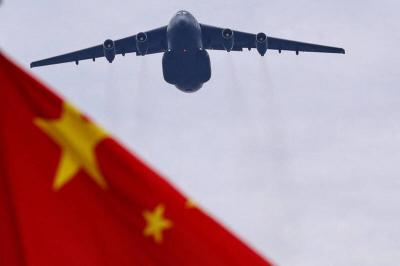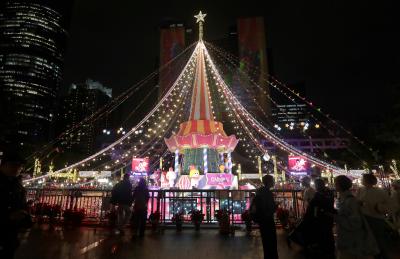The nation’s landmark skyscraper Taipei 101 is seeking to become the world’s tallest green building, its owner Taipei Financial Center Corp (TFCC) announced on Monday.
TFCC chairman Harace Lin (林鴻明) said the company plans to apply for Leadership in Energy and Environment Design (LEED) certification for the building. To obtain that certification, Lin said Taipei 101 would invest NT$60 million (US$1.8 million) over the next 18 months to undergo hundreds of building modifications during the certification process. After the transformation is completed, it is estimated that Taipei 101 will save NT$20 million in energy costs each year.
Lin said that the company wants Taipei 101 to not only be profitable, but also to be an international model of environmental protection and social responsibility.
“Taipei 101’s management team is expecting to make it an icon of green building industry in Taiwan and worldwide,” Lin said. “As the world’s tallest building, Taipei 101 aims to raise people’s awareness about our environment and be a pioneer of international green building certification for existing buildings.”
The 509m tall Taipei 101, completed in 2004, was overtaken in height on July 21, 2007 by the Burj Dubai in Dubai, UAE, upon the completion of that building’s 141st floor.
The title of “world’s tallest building” still rests with Taipei 101, however, as international architectural standards define a “building” as a completed occupied structure.
Developed by the US Green Building Council, LEED is the world’s largest and fastest-growing green building certification program that provides a suite of standards for environmentally sustainable construction. Initial results of inspections conducted by energy-saving consultants Steven Leach Associates, EcoTech International and Siemens’ Building Automations Business Unit shows that Taipei 101 installed several green elements during the original design and construction, including the double pane low-emission glass curtain wall — which reflects heat, but lets in light — a waste recycling program, a gray water system and the building energy management system, Lin said.
However, Taipei 101 is still required to make more green improvements, including increasing green landscape, checking the lighting systems thoroughly for where energy-saving light bulbs can be used and tubes can be replaced, as well as maximizing the use of local food in the restaurants in the building to reduce carbon emissions in delivery, he added.
Rob Watson, chairman and CEO of EcoTech International and founder of LEED, said in a statement that given the fact that building construction and use emits more pollution than any other human activity, it is especially important that iconic landmarks such as Taipei 101 take “credible, verified and measured results” to reduce energy and water use.

Beijing could eventually see a full amphibious invasion of Taiwan as the only "prudent" way to bring about unification, the US Department of Defense said in a newly released annual report to Congress. The Pentagon's "Annual Report to Congress: Military and Security Developments Involving the People's Republic of China 2025," was in many ways similar to last year’s report but reorganized the analysis of the options China has to take over Taiwan. Generally, according to the report, Chinese leaders view the People's Liberation Army's (PLA) capabilities for a Taiwan campaign as improving, but they remain uncertain about its readiness to successfully seize

Taiwan is getting a day off on Christmas for the first time in 25 years. The change comes after opposition parties passed a law earlier this year to add or restore five public holidays, including Constitution Day, which falls on today, Dec. 25. The day marks the 1947 adoption of the constitution of the Republic of China, as the government in Taipei is formally known. Back then the Chinese Nationalist Party (KMT) governed China from Nanjing. When the KMT, now an opposition party in Taiwan, passed the legislation on holidays, it said that they would help “commemorate the history of national development.” That

Taiwan has overtaken South Korea this year in per capita income for the first time in 23 years, IMF data showed. Per capita income is a nation’s GDP divided by the total population, used to compare average wealth levels across countries. Taiwan also beat Japan this year on per capita income, after surpassing it for the first time last year, US magazine Newsweek reported yesterday. Across Asia, Taiwan ranked fourth for per capita income at US$37,827 this year due to sustained economic growth, the report said. In the top three spots were Singapore, Macau and Hong Kong, it said. South

Snow fell on Yushan (Jade Mountain, 玉山) yesterday morning as a continental cold air mass sent temperatures below freezing on Taiwan’s tallest peak, the Central Weather Administration (CWA) said. Snowflakes were seen on Yushan’s north peak from 6:28am to 6:38am, but they did not fully cover the ground and no accumulation was recorded, the CWA said. As of 7:42am, the lowest temperature recorded across Taiwan was minus-5.5°C at Yushan’s Fengkou observatory and minus-4.7°C at the Yushan observatory, CWA data showed. On Hehuanshan (合歡山) in Nantou County, a low of 1.3°C was recorded at 6:39pm, when ice pellets fell at Songsyue Lodge (松雪樓), a